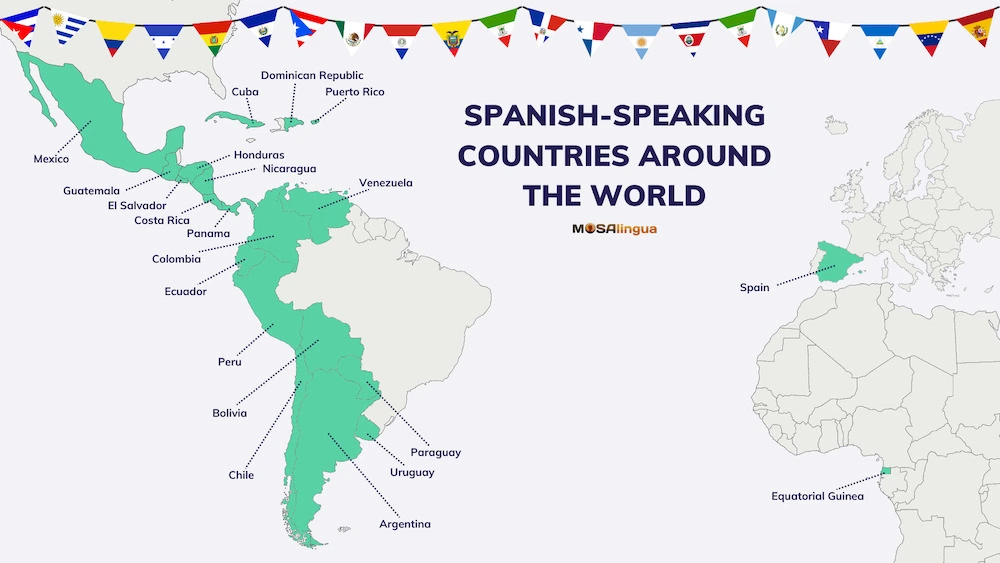In recent years, there’s been a surge in the popularity of learning Spanish while exploring the world. It’s not just about mastering a new language; it’s also about immersing yourself in the vibrant cultures of Spanish speaking countries. But before you pack your bags and embark on this exciting journey, it’s crucial to choose the right destination that suits your learning style and preferences.
In this article, we’ll walk you through the factors you should consider when selecting the perfect Spanish-speaking country for your language-learning adventure. Plus, we’ll also explore an alternative option: learning Spanish in the comfort of your own home.
Factors to Consider When Choosing a Spanish-Speaking Country
Proximity and Ease of Travel
First things first, think about how far you’re willing to go. The proximity of the country to your home base can greatly affect your travel experience. If you’re based in the United States, for instance, Mexico might be a convenient choice with short flight times and numerous affordable flights. On the other hand, if you’re in Europe, Spain could be just a stone’s throw away.
Dialect Variations and Regional Accents
Spanish isn’t a one-size-fits-all language. Different countries have their own unique dialects and accents. For instance, the Spanish spoken in Spain varies from the Spanish spoken in Mexico or Argentina. Consider which dialect you’d like to learn and immerse yourself in. Your choice here can greatly impact your comprehension and communication skills.
Cost of Living and Affordability
Budget matters, right? Learning Spanish abroad can be cost-effective, but it’s essential to assess your financial comfort zone. Some countries, like Mexico and Colombia, are known for their affordability, while others, like Spain, might be a bit pricier. Think about your budget for accommodations, food, and leisure activities when making your decision.
Safety and Political Stability
Your safety should always come first. Before selecting a destination, research the current safety and political stability in the region. Ensure that the country you choose has a stable environment that allows for safe exploration and language learning.
Cultural Attractions and Diversity
Lastly, consider what else the country has to offer besides language learning. Do you want to be surrounded by lush natural landscapes, bustling cities, or historical sites? Every Spanish-speaking country boasts its unique cultural attractions.
For instance, if you’re passionate about tango and steaks, Argentina might be your dream destination. If you prefer beaches and rainforests, Costa Rica could be your paradise.
Top Spanish-speaking countries for Travel and Learning Spanish
A. Spain

Overview of Language Schools and Immersion Programs
Spain, the birthplace of the Spanish language, is a fantastic destination to embark on your language-learning journey. It’s home to a plethora of language schools and immersion programs that cater to learners of all levels.
From the bustling streets of Madrid to the sun-soaked beaches of Barcelona, there’s a diverse range of options for where and how you can learn.
Unique Cultural Experiences in Spain
When you choose Spain, you’re not just choosing a place to learn Spanish; you’re choosing a cultural adventure. You can witness the vibrant traditions of flamenco dancing, indulge in delectable tapas, and explore centuries-old cathedrals. Spain’s rich history and dynamic culture will make your language-learning experience truly memorable.
Pros and Cons of Learning Spanish in Spain
Pros:
- Authenticity: Learning from native speakers exposes you to the true essence of the language.
- Immersive Environment: Everyday interactions become opportunities for practice.
- Networking: Connect with a global community of learners and fellow travelers.
Cons:
- Not any Specific Con
Cost:
Spain can be relatively more expensive compared to some Latin American countries.
Dialect: The Spanish spoken in Spain has distinct dialects, which may vary from Latin American Spanish.
B. Mexico

Language Learning Opportunities in Mexico
Mexico, with its warm hospitality and diverse landscapes, is a popular choice for Spanish learners. Many language schools across the country offer immersive programs where you can learn Spanish in a relaxed and friendly environment. Picture yourself taking lessons under the swaying palms or in charming colonial towns.
Exploring Mexican Culture and Heritage
Mexico is more than just a language classroom; it’s a cultural treasure trove. You can explore ancient Mayan ruins, savor authentic street tacos, and experience the vibrant traditions of Dia de los Muertos. Immersing yourself in Mexican culture is an integral part of learning Spanish here.
Benefits of Choosing Mexico as a Learning Destination
- Affordability: Mexico is known for its affordability, making it an excellent choice for budget-conscious travelers.
- Varied Scenery: From pristine beaches to bustling cities and serene mountains, Mexico offers diverse experiences.
- The warmth of the Locals: Mexicans are renowned for their friendliness and willingness to help learners practice their Spanish.
C. Argentina

Tango Your Way to Fluency – The Argentine Experience
If you’ve ever dreamt of dancing the tango while speaking Spanish fluently, Argentina is the place for you. It’s a country that’s passionate about both dance and language. Many language schools in Buenos Aires, the tango capital, offer immersive experiences where you can learn Spanish by dancing your heart out.
Language Schools and Programs in Argentina
Argentina’s language schools are known for their high-quality instruction. They combine formal lessons with practical conversational experiences. Whether you’re exploring the vibrant neighborhoods of Buenos Aires or the stunning landscapes of Patagonia, you’ll find opportunities to practice your Spanish.
Discovering Argentina’s Rich History and Landscapes
From the bustling streets of Buenos Aires to the breathtaking beauty of Iguazu Falls, Argentina is a land of diverse landscapes and rich history. Learning Spanish here means delving into the fascinating stories that shaped the nation, from the indigenous cultures to European influences.
D. Colombia

The Rise of Colombia as a Language Learning Hub
Colombia has emerged as a sought-after destination for Spanish learners in recent years. Its cities, such as Medellin and Bogota, are bustling with language schools and vibrant communities of learners. The country’s improving safety and stability have contributed to its popularity.
Exploring Colombian Culture and Cuisine
Colombia’s cultural tapestry is woven with threads of indigenous, African, and Spanish influences. You can immerse yourself in the rhythms of cumbia, savor delicious arepas, and learn about the country’s fascinating history. Colombians are known for their friendly nature, making it easy to practice your Spanish.
Safety and Affordability in Colombia
Colombia has made significant strides in improving safety for travelers. It’s also known for being budget-friendly, offering excellent value for language learners. The affordability of living and learning in Colombia is a significant draw for many.
E. Costa Rica

Eco-Friendly Language Learning in Costa Rica
If you’re a nature enthusiast, Costa Rica is your perfect learning haven. This eco-friendly country offers not just language learning but also an opportunity to immerse yourself in breathtaking natural landscapes. Imagine studying Spanish while surrounded by lush rainforests and exotic wildlife.
Biodiversity and Outdoor Adventures
Costa Rica boasts incredible biodiversity. You can explore national parks, hike through tropical forests, and even try your hand at surfing along its pristine coastlines. Learning Spanish here means discovering the wonders of nature while mastering a new language.
Why Costa Rica Is Ideal for Nature-Loving Learners
- Sustainable Learning: Eco-friendly initiatives align with Costa Rica’s commitment to environmental conservation.
- Pura Vida Lifestyle: Experience the “Pura Vida” way of life, emphasizing happiness, well-being, and a stress-free environment.
- Rich Eco-Tourism Opportunities: Engage in activities like bird-watching, zip-lining, and wildlife spotting while practicing your Spanish.
Learning Spanish at Home Before Travel
A. Benefits of Preparing at Home Before Embarking on a Language-Learning Journey
Before you hop on a plane to a Spanish-speaking country, consider the advantages of getting a head start on your language skills right at home.
- Building a Strong Foundation: Learning the basics of Spanish before you travel can provide you with a solid foundation. This groundwork will help you communicate effectively and with more confidence when you arrive at a Spanish-speaking destination.
- Reducing Travel Stress: Traveling to a foreign country can be overwhelming. Having a basic grasp of the language can reduce the stress associated with navigating transportation, ordering food, and seeking assistance.
- Maximizing Immersion: When you already know some Spanish, you can make the most of your immersive experience abroad. You’ll be better equipped to engage with locals and take full advantage of language exchange opportunities.
B. Recommended Resources and Methods for Learning Spanish Independently
Learning Spanish at home doesn’t have to be daunting. Here are some resources and methods to help you on your journey:
- Online Language Courses and Tutors: Consider exploring online language courses and tutors as viable options. You can find various online platforms such as Duolingo, Babbel, and Rosetta Stone that offer interactive Spanish courses. These resources typically offer structured lessons and chances for practice. For instance, if you’re in New York, you might want to think about hiring a native Spanish tutor in New York or enrolling in a local school that offers Spanish courses. Similarly, if you’re from Toronto, you can explore similar options available in your area.
- Language Apps: Mobile apps like Memrise and Tandem make it easy to learn Spanish on the go. They offer lessons, quizzes, and the chance to connect with native speakers for conversation practice.
- Language Learning Websites: Websites like SpanishDict and StudySpanish.com provide free lessons, grammar explanations, and vocabulary resources. They’re valuable for self-paced learning.
- Language Exchange Partners: Connect with native Spanish speakers who want to learn your language. Language exchange can be done in person or virtually through platforms like Tandem or ConversationExchange.
- Spanish Books and Audiobooks: Invest in Spanish textbooks, phrasebooks, and audiobooks. They offer structured learning and can be a valuable reference when you have questions.
- Online Communities and Forums: Join online forums or Facebook groups dedicated to Spanish learners. They offer a space for asking questions, sharing experiences, and finding study partners.
C. How to Set Achievable Language Learning Goals at Home
Setting clear goals is essential for effective language learning. Here’s how to establish achievable objectives while learning Spanish at home:
- Define Your Objectives: Determine why you want to learn Spanish. Is it for travel, work, or personal enrichment? Your goals will guide your learning path.
- Break It Down: Divide your goals into smaller, manageable tasks. For example, focus on mastering basic conversational phrases before delving into complex grammar rules.
- Set a Schedule: Dedicate a specific amount of time each day or week to studying Spanish. Consistency is key to progress.
- Use SMART Goals: Make your goals Specific, Measurable, Achievable, Relevant, and Time-bound. For instance, “I will learn 50 Spanish vocabulary words in one month.”
- Track Your Progress: Keep a journal or use language learning apps that track your progress. Seeing how far you’ve come can be motivating.
- Practice Regularly: Language learning is a skill that requires practice. Engage in reading, writing, listening, and speaking exercises regularly to reinforce what you’ve learned.
- Be Patient and Persistent: Learning a language takes time. Don’t be discouraged by challenges or setbacks. Stay committed to your goals.
By preparing for your language-learning journey at home, you’ll not only boost your confidence but also enhance your overall experience when you eventually travel to a Spanish-speaking country. Learning Spanish is an exciting adventure, and the efforts you put in advance will pay off in your ability to fully immerse yourself in the language and culture.
Tips for Successful Language Learning Abroad
Learning a new language while abroad is a rewarding adventure. Here are some tips to ensure your language-learning journey is both successful and enjoyable:
A. Setting Realistic Language Goals
- Start with Small Steps: Setting achievable language goals is essential. Begin with basic conversational skills and gradually work your way up to more complex language aspects like grammar and idiomatic expressions.
- Use SMART Goals: Make your language goals Specific, Measurable, Achievable, Relevant, and Time-bound. For example, aim to hold a 10-minute conversation with a local in Spanish within two months.
- Reevaluate and Adjust: As you progress, regularly reassess your goals. Adjust them to match your evolving language skills and objectives.
B. Engaging with Local Communities and Practicing Conversational Spanish
- Don’t Be Shy: One of the best ways to learn a language is by speaking it. Don’t be afraid to talk with locals, even if your skills are limited. Most people appreciate the effort and are willing to help.
- Language Exchange: Seek out language exchange partners or conversation partners in the local community. This provides a structured opportunity for language practice and cultural exchange.
- Use Everyday Situations: Utilize everyday situations, like ordering food at a restaurant or shopping, as opportunities to practice your Spanish. Even short interactions can be valuable learning experiences.
C. Balancing Structured Lessons with Immersion Experiences
- Enroll in Language Classes: Consider enrolling in language courses at local schools or language centers. Structured lessons can provide a strong foundation and guidance in your language learning.
- Immerse Yourself: Immersion experiences are invaluable. Attend local events, festivals, and gatherings to experience the language and culture in action.
- Combine Learning and Exploration: Plan trips to historical sites, museums, and cultural attractions where you can absorb the language while exploring the country’s heritage.
D. Adapting to Cultural Differences
- Cultural Sensitivity: Learn about the cultural norms and etiquette of the country you’re in. Being respectful of local customs will help you build positive relationships with native speakers.
- Open-Mindedness: Embrace cultural differences with an open mind. Be willing to step out of your comfort zone and try new things. This can lead to enriching experiences and deeper language learning.
- Learn from Locals: Engage in conversations with locals not only to practice language but also to gain insights into their way of life, traditions, and values. These cultural exchanges can be incredibly educational.
Remember that language learning is a gradual process, and it’s okay to make mistakes. Embrace these tips, stay patient, and enjoy the journey of discovering a new language and culture. The experiences and connections you gain while learning Spanish abroad will be priceless.





